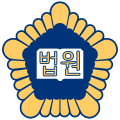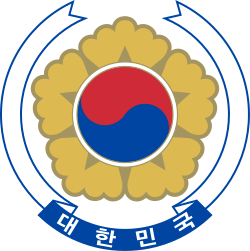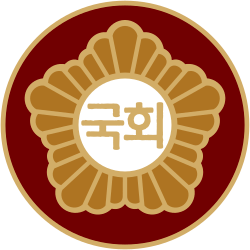Supreme Court of South Korea
| Supreme Court of the Republic of Korea | |
|---|---|
| 대한민국 대법원 | |
 Badge of the Court | |
| Established | 1948 |
| Country | South Korea |
| Location | Seocho, Seoul, South Korea |
| Authorized by | South Korean Constitution |
| Judge term length | Six years (renewable until mandatory retirement at the age of 70) |
| No. of positions | 14 |
| Website |
www |
| Chief Justice of Korea | |
| Currently | Kim Myeong-soo |
| Since | 25 September 2017 |
| Supreme Court of Korea | |
 | |
| Korean name | |
|---|---|
| Hangul | 대법원 |
| Hanja | 大法院 |
| Revised Romanization | Daebeobwon |
| McCune–Reischauer | Taebŏbwon |
The Supreme Court of Korea is the highest court in South Korea. It is located in Seoul. Articles 101–110 of the Constitution of the Republic of Korea establish the Supreme Court and enumerate its powers and responsibilities. Although the Supreme Court is the highest court for most legal issues, the Constitutional Court of Korea is the court of last resort for more specialized constitutional issues such as impeaching presidents or dissolving political parties.
Composition
 |
|---|
| This article is part of a series on the politics and government of the Republic of Korea |
| Constitution |
|
Judiciary |
The Supreme Court of Korea is composed of the Chief Justice of the Republic of Korea, and 13 other Supreme Court Justices, 12 of which have adjudicatory functions. The 13th justice of the Supreme Court is appointed by the Chief Justice as the Minister of Court Administration, and does not participate in rendering judicial opinions.
The Chief Justice of Korea is appointed to the court by the President with the consent of the National Assembly of South Korea, and serves a non-renewable term of six years from the time of appointment. The Chief Justice acts as the head of the judicial branch of the Republic of Korea, and has broad administrative powers under the Constitution, including the right to recommend other justices to the Supreme Court and the right to appoint judges of the inferior courts. The current Chief Justice is Yang Sung-Tae.
The 13 other Justices are appointed to the court by the President on the recommendation of the Chief Justice and the consent of the National Assembly, and serve renewable terms of six years.
By law, to be eligible for appointment to the Supreme Court, a person must be over 40, and have spent at least 15 years:
- as a judge, public prosecutor, or lawyer or
- engaged in legal affairs at the state organs, local governments, state-run or public enterprises, state-financed institutions while qualified as a lawyer or
- in an office higher than assistant professor in the field of jurisprudence at an authorized college or university while qualified as a lawyer.
For the most part, Supreme Court Justices are appointed from the bench.
Supreme Court Justices are required to retire at age 70.
Current justices
| Name | Born | Appointed by | Recommended by | Education | First day / Length of service |
|---|---|---|---|---|---|
| Kim Myeong-soo | October 12, 1959 (age 59) in Busan, Gyeongsangnam-do |
Moon Jae-in | Seoul National University | September 25, 2017 1 year | |
| Ko Young-han | February 7, 1955 (age 63) in Gwangju, Jeollanam-do |
Lee Myung-Bak | Yang Sung-tae | Seoul National University | August 13, 2012 6 years, 2 months |
| Kim Chang-suk | March 2, 1956 (age 62) in Boryeong, Chungcheongnam-do |
Lee Myung-Bak | Yang Sung-tae | Korea University | August 13, 2012 6 years, 2 months |
| Kim Shin | March 30, 1957 (age 61) in Busan, Gyeongsangnam-do |
Lee Myung-Bak | Yang Sung-tae | Seoul National University | August 13, 2012 6 years, 2 months |
| Kim So-young | November 17, 1965 (age 52) in Changwon, Gyeongsangnam-do |
Lee Myung-Bak | Yang Sung-tae | Seoul National University | November 2, 2012 5 years, 11 months |
| Jo Hee-de | June 6, 1957 (age 61) in Gyeongju, Gyeongsangbuk-do |
Park Geun-hye | Yang Sung-tae | Seoul National University | March 4, 2014 4 years, 7 months |
| Kwon Soon-il | July 26, 1959 (age 59) in Nonsan, Chungcheongbuk-do |
Park Geun-hye | Yang Sung-tae | Seoul National University | September 8, 2014 4 years, 1 month |
| Park Sang-ok | November 13, 1956 (age 61) in Siheung, Gyeonggi-do |
Park Geun-hye | Yang Sung-tae | Seoul National University | May 8, 2015 3 years, 5 months |
| Lee Ki-taik | July 9, 1959 (age 59) in Seoul |
Park Geun-hye | Yang Sung-tae | Seoul National University | September 17, 2015 3 years, 1 month |
| Kim Jae-hyung | January 23, 1965 (age 53) in Imsil, Jeollabuk-do |
Park Geun-hye | Yang Sung-tae | Seoul National University | September 5, 2016 2 years, 1 month |
| Cho Jae-youn | June 1, 1956 (age 62) in Donghae, Gangwon-do |
Moon Jae-in | Yang Sung-tae | Sungkyunkwan University | July 19, 2017 1 year, 3 months |
| Park Jung-hwa | October 3, 1965 (age 53) in Haenam, Jeollanam-do |
Moon Jae-in | Yang Sung-tae | Korea University | July 19, 2017 1 year, 3 months |
| Ahn Chul-sang | March 5, 1957 (age 61) in Hapcheon, Gyeongsangnam-do |
Moon Jae-in | Kim Myeong-soo | Konkuk University | January 2, 2018 9 months |
| Min You-sook | January 31, 1965 (age 53) in Seoul |
Moon Jae-in | Kim Myeong-soo | Seoul National University | January 2, 2018 9 months |
Research judges
The Supreme Court also employs a number of research judges, whose function is to assist the Justices in researching their opinions. These research judges may either be assigned to a particular justice, or else belong to a 'pool' that provides assistance to any Justice. The research judges are appointed from among the judges of the other courts, usually presiding judges of the district courts or else associate judges of the high courts. As of September 2012, there are 106 research judges including 1 Chief research judge and 1 Senior research judge. In addition, there are 10 non-judge researchers.
Jurisdiction
As the court of last resort for the Republic of Korea, the Supreme Court has appellate jurisdiction over cases in the South Korean legal system. Additionally, the Supreme Court has original jurisdiction over challenges to the validity of a presidential or parliamentary election and the power to review the constitutionality and legality of rules, orders, regulations, and actions of administrative entities.
Procedure
Petty Benches
The Supreme Court is organized into three Petty Benches, each consisting of four Justices. Normally, the Petty Benches hear cases from the lower courts, which they may overturn by consensus. Should the Petty Bench assigned to a case fail to reach a consensus, the case will be heard by the Grand Bench.
The Grand Bench
The Grand Bench must be composed of more than two-thirds of the Justices and be presided over by the Chief Justice. Unlike the Petty Benches, the Grand Bench can enter judgments by simple majority, rather than needing a consensus. If no majority can be reached amongst the Justices sitting on the Grand Bench, the judgment of the lower court is sustained by default. In addition to cases that fail to garner a consensus in one of the petty benches, the Grand Bench also hears cases where it is deemed that any order, rule, or regulation is in violation of the laws or the Constitution, where a previous opinion of the Supreme Court needs modification, or in cases where adjudication by the Petty Benches would not be appropriate.
Administrative function
In addition to its adjudicative functions, the Supreme Court is also responsible for the administration of the South Korean court system.
The Supreme Court Justices Council
The Supreme Court Justices Council comprises the highest body of court administration in the Republic of Korea. This council is presided over by the Chief Justice, with all of the Justices of the Supreme Court sitting on the Council. The Council has the power to promulgate the rules of procedure for the Supreme Court and lower courts, select judicial precedents for publication, request the budget for the judicial branch, and rule on other matters which are referred to it by the Chief Justice. In addition, the Council is responsible for confirming the nominations of the Chief Justice of judges for the lower courts.
To pass a resolution, the Justices Council requires a quorum of more than two-thirds of the Justices of the Supreme Court, a majority of which must approve of the proposed measure. The Chief Justice has a vote on the Council, and is given the prerogative to cast the deciding vote in the event of a tie.
The National Court Administration
The National Court Administration is headed by the Minister of the National Court Administration, and handles much of the daily operation and general administrative duties of the judicial branch. The Minister and Vice Minister of the National Court Administration have the right to address the National Assembly and the State Council on issues related to court administration.
Location
The court and its administrative offices are housed in a 66,500 square meter building located at 967 Seocho-dong, Seocho-gu, Seoul. This has been the home of the Supreme Court of South Korea since December 1, 1995. Before moving to its new building, the court was housed in a 10,300 square meter building built in 1928 as well as two annex buildings at 37 Seosomun-dong, Jung-gu, Seoul.
See also
| Wikisource has several original texts related to: Supreme Court of Korea decisions |
External links
Coordinates: 37°29′32″N 127°00′19″E / 37.4922°N 127.0052°E

